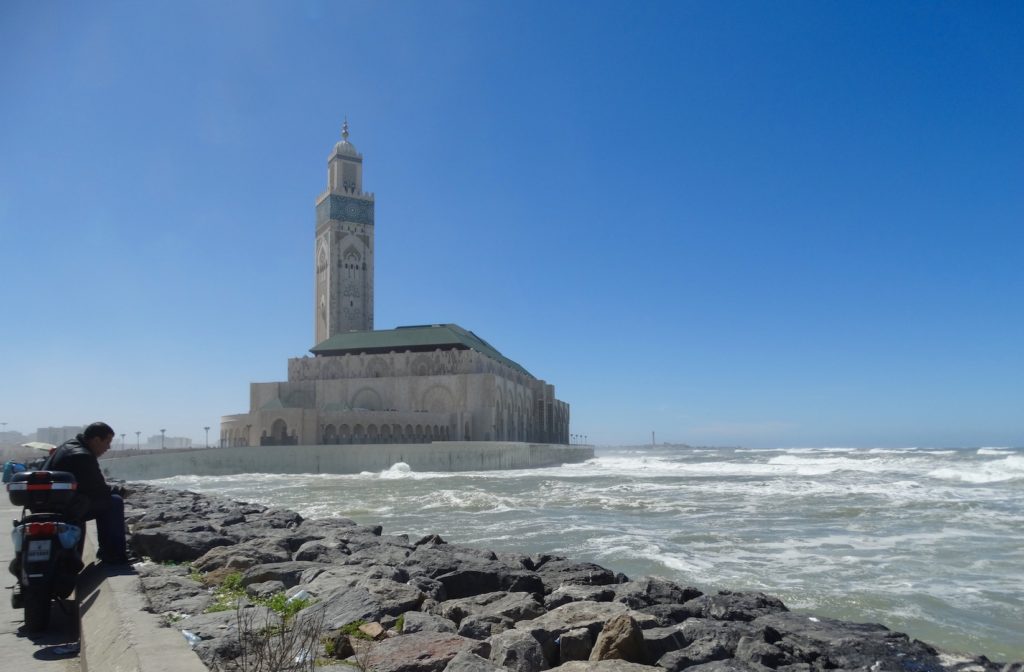YOGA CLASSES IN CASABLANCA

The draw of mountains, coastline, desert and history had cemented Morocco as an intended destination for several years. However, I hadn’t envisioned a scenario where I’d spend much of my time there doing yoga classes in Casablanca. In fact, the country’s economic hub had barely been on my radar, with Marrakech blinking far brighter in my sights.
Volunteering vs Sightseeing
When you prioritise doing voluntary work over sightseeing you have to be flexible. You might go to places that don’t jump out of guide books or travel blogs, brimming with glowing recommendations. Equally, the nature of the voluntary work may not always tie in with your chosen vocation or interests. Fortunately, I was keen to make some progress with my yoga and this placement offered just that. In fact, unlimited classes and accommodation in return for some light marketing and content writing tasks. Overall, it thought it was a good compromise and life is full of compromises, moderation and, as we’re often told as children, unfairness.
The History of Casablanca
Where to begin with Casablanca? In it’s current form, Casa is a relatively modern city, built by the French in the 1930’s. Architecturally, it is a patchwork of Art Deco, Art Noveau, Art Garfunkel and What is Art? The trad itional flat roofs of the Mahgreb sit alongside modern apartment blocks, opulent villas and sprawling shanty towns. It’s a heady mix, which is at once jarring and charming. What is immediately apparent in the French era structures is the dilapidation. The crumbling facades look all the more forlorn in their grubby white hue, like crumpled dress shirts that have been to too many weddings. Thankfully, some organisations are pushing to have parts of Casa protected under the UNESCO World Heritage banner.
Of course, long before the boulevards and bustling port were established under the French protectorate, it was a Berber village called Anfa. The residents favoured its strategic position form where they could launch attacks on passing Christian ships in the 12th Century. The Portuguese also ruled there before the Sultan of Morocco, Mohammed ben Abdallah reclaimed it in the late 18th century. After half a century under French control, Moroccan sovereignty was reasserted under the tutelage of King Mohammed V in 1956.
Yoga in Morocco
Yoga in Morocco seems to be separated into two markets. The most visible caters to travellers, adorned in loose fitting clothing and leather jewelry, who often combine a short yoga course with surfing in the beach towns of the Atlantic coast. Yoga classes in Casablanca, however, tend to be purely yoga focused and characterised by membership, SUVs and cosmetics. These are, of course, sweeping generalisations, but nevertheless based on my observations; in particular the second group who I had daily exposure to over the course of two months. The nascent yoga scene in Morocco is still finding its feet, slightly bent legs and straight back. Therefore, it’s only natural that it isn’t more accessible to the wider population. Having said that, the premium membership prices, designer handbags and parking arrangements gave it a very country club feel.
Elitist Yoga in Casablanca
The centre is located near the coast in the north west of the city, in the wealthy Ain Diab area. Wide streets, expansive villas and high perimeter walls abound. And, I think it’s worth touching on the parking mentioned above. Rather than parking directly in front of the property, members parked in a larger area around one hundred metres along the street; directed by a jovial member of staff from Senegal. From there, another member of staff – also from Senegal but far less jovial – drove them the remaining distance from their cars to the front gate in a small van.

Now, I’m sure that there was a good reason for having a designated parking area away from the front entrance. But it was hard to accept that they couldn’t walk for around 45 seconds to arrive at the place where they were supposed to be exerting themselves physically and enriching themselves spiritually.
I half wondered if it wouldn’t be long before a coolie transferred them to a palanquin – a covered chair originating in the Indian subcontinent carried by between two and eight bearers – and carried the remaining distance from the gate, past reception, into the yoga shala and deposited as delicately as possible on their mat like a sedated tiger.
Yoga Etiquette
In many ways, going to yoga classes in Casablanca is like practicing anywhere in the world. As such, the benefits that can be derived from it are dependent on a multitude of factors and forces. From the external, like the quality of the teacher; to the physical, like the practitioner’s ability to replicate the asanas; and the more nuanced, like our willingness to commit to the doctrine. There, I said it, the doctrine.
Now, this isn’t the place to dive into a polemic on rigid yoga purists or the guiding principles and rituals that formed the practice over 5000 years ago. But, the bottom line is, like Larry David, I don’t say ‘Namaste’ at the end. I wish I could offer a logical and mature reason for not doing it, but it just feels a bit too close to “Amen” for a sceptic like me. Moreover, I’m loathe to mutter it under my breath without conviction or integrity like many yogis do.
Namaste aside, I’d like to think that I observe the vast majority of the etiquette surrounding yoga. Even more so since hearing the perspective of a fellow volunteer and instructor. She was seething about the behaviour of an attendee of one of her classes. This related to her routinely fixing her hair, starting poses after the rest of the class and even leaving before completing ‘Shavasana’ (the meditative, relaxation phase at the end of the class). This could certainly be perceived as showing a lack of respect for the instructor, the other yogis and the practice itself. After all, refusing to shake hands at the end of a football match or playing on your phone during a Uni seminar would be considered equally bad form.
Yoga’s Evolution
Numerous styles of yoga have evolved and proliferated over the years. However, it is perhaps only in the last 20 years that yoga has become mainstream, breaking out of specialist studios and communities and entering gyms, schools, parks and people’s homes. The success of yoga is in part due to how instructors and centres have adapted it to suit a variety of markets and needs. But this has left many yoga purists dismayed at the perceived dilution of its true ethos and practice. Modern styles have incorporated other exercise forms, dance, gymnastics and even animals to try and appeal to as wide a demographic as possible.
‘Yoga purist’ is in itself a problematic term. After all, what qualifies someone to dismiss an emerging practice as adulterated or inferior? A 200 hour teacher training course in Bali with fellow wealthy westerners, experimenting with a plant-based diet and commemorated with a hand-tapped tattoo? Perhaps the more rightful custodians of pure yoga practice are people from India or the wider Hindu diaspora. A decade ago, The Hindu American Foundation launched the Take Back Yoga campaign. It aimed to highlight the concealment of yoga’s Hindu roots in the modern forms, where the physical supplants the spiritual. No doubt the debate will rage on – although presumably offset by controlled breathing – among dedicated yogis, instructors, casual practitioners and even SUV driving park and riders.
Finding My Style
After trying lots of different yoga classes in Casablanca I found a home in both the modern and traditional; enjoying strenuous Power yoga and the dynamic flow of Vinyasa. It was sometimes hard to identify the moral virtues that underpin yoga practice in the environment that I was in. However, it was also very comfortable and I was among people that I could easily find common ground and friendship.
There were occasions at the end of classes where some yogis were in tears, the instructor offering comforting words. I find this hard to identify with because, overall, I find yoga uplifting, rather than cathartic. Ultimately, we all experience yoga differently. What’s important is that we use our time on the mat to sustain or augment various aspects of our existence, irrespective of whether we walk to the entrance or say Namaste at the end.